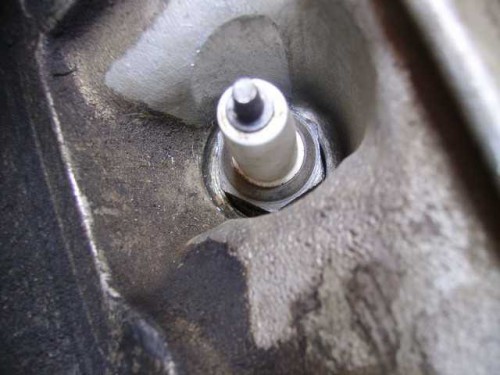
The original spark plugs for the Volga engines are marked according to the Soviet GOST 2043-74 technical standard:
- A11 for low-compression 2401 engine;
- A17V for high-compression 24D engine;
- A14V for 402.10 & 4021.10 (after 1985) & 4022.10 (GAZ-3102) engines.
The numbers in these designations are the heat ranges of the spark plugs measured according to the GOST standard (an article about spark plugs heat ranges). Plugs with lower GOST heat ranges (“hot”) run hotter than plugs with higher heat ranges (“cold”). E.g., A11 is “hotter” than A14V, and A17V is “colder” than A14V (“V” stands for projected insulator tip).

Other spark plug numbering systems may be opposite to this (the higher the number, the hotter the plug), as shown on the picture above. But the definitions of “cold” and “hot” plugs are universal.
As a rule of thumb, the higher cylinder pressure and temperature are – the “colder” spark plugs are required. That means that engines with more specific power, higher compression ratio, working at higher RPMs or under heavier load, etc., require “colder” spark plugs – while low-revving, under-stressed engines need “hotter” plugs to prevent fouling build-up. Air-cooled engines, which run very hot, usually require very “cold” plugs (GOST heat ranges 23–26), and side-valve engines often employ very “hot” plugs (8–10).
Spark plugs with a wrong heat range for the engine may cause malfunction and/or equipment damage. E.g., spark plugs which are too “hot” may cause overheating and pre-ignition (engine knocking), and spark plugs which are too “cold” tend to foul quickly, causing engine misfire and loss of power.
Note that all of these spark plugs have a short threaded section. It is very important to use only spark plugs with a short threaded section in these engines.
As of 2019, this GOST is still in action and the spark plugs of the above mentioned types are widely available on the markets of the former USSR countries.
However, it is convenient to have a choice of internationally available analogs, which are listed in this table:
| GOST 2043-74 | AUTOLITE | BERU | BOSCH | BRISK | CHAMPION | EYQUEM | MAGNETI MARELLI | NGK | NIPPON DENSO |
| A11 | 425 | 14-9A | W9A | N19 | L86 | 406 | FL4N | B4H | W14F |
| A14V | 275 | 14-8B | W8B | N17Y | L92Y | 550S | FL5NR | BP5H | W16FP |
| A17V | 273 | 14-7B | W7B | N15Y | L87Y | 600S | FL6NP | BP6H | W20FP |
The “intermediate” A14V spark plugs are kind of universal for these engines – they work “good enough” both in low-compression and high-compression engines.
If the car is used sparingly and only sees light loads (short weekend trips around town, as typical for many classic cars), it may be beneficial to use “hotter” plugs to prevent fouling, e.g. A14V instead of A17V. Heavy loads and frequent high speed driving, on the other hand, may require “colder” plugs.
If 92-octane (RON) gas is used in a low-compression engine, A14V spark plugs (or analogs) must be installed instead of A11, which become too “hot” in this case. Ignition timing also has to be altered slightly by advancing it by roughly 4 degrees (crankshaft), which is equal to one division of the “octane correction” scale of the distributor towards “+” (see also the article about ignition timing).
Spark plug gap is 0.8–0.9 mm (0.31–0.35 in).
The spark plugs used in the original point-type ignition system of 24D and 2401 engines did not have terminal nuts, just bare thread on their terminals:

That is because 10 kΩ resistor spark plug caps were used originally to prevent the ignition system from interfering with the radio transmission, and they were designed to be mounted on a spark plug without a terminal nut. These resistor caps are only necessary if you use copper core high tension wires and non-resistor spark plugs.
By the way, three distinct designs of resistor spark plug caps were used. The earliest cars came with the same 90-degrees bent caps that were used on the GAZ-21 (SE-12); later straight caps were used (SE-14), and the latest cars may have straight caps with a metal screen (ENS-105).
All carbon core wires have sufficient resistance to prevent the electromagnetic radio-frequency interference, and some modern spark plugs also have built-in resistors. In all of these cases, everything you’ll get from the resistor caps is less energy available for the spark, so just throw them away unless you wish to keep the car as original as possible (then use non-resistive copper core wires and resistor caps).
